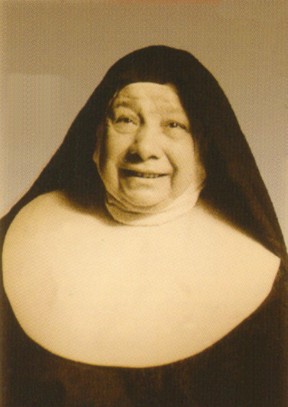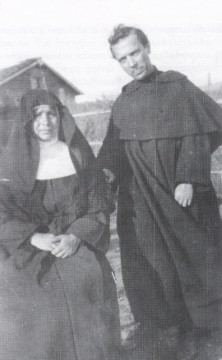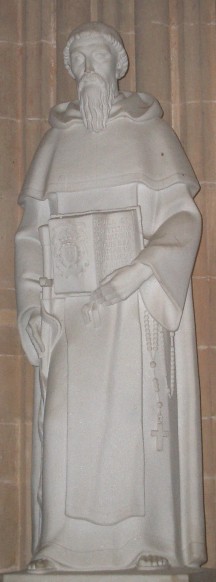|
no. 2 april - june 2004
MAKING THE SAINTS OF CARMEL TODAY P erhaps one of our Order’s greatest contributions to the Church has been the men and women who have professed to live life in Carmel and who did so with such fervor and single-mindedness that the Church has officially recognized their holiness and proclaimed them "saints."In recent issues of CITOC, there have been articles about the canonization processes for Titus Brandsma, Maria Teresa Scrilli, Asunción Soler Gimeo, and Barolomé Xiberta. In this issue, we explore two more of "our own" who are being considered for sainthood. We also publish an interview with one of the people responsible for "saint making" in the Carmelite Family, the Postulator General, Felip Amenos. He has also provided a status report on the many cases which we gladly publish here. In the coming months, a website for the Office of the Postulator General will be developed. This will allow you and others around the world to have ready access to these incredible people who lived our life and whose examples remain with us today.
The Istituto delle Suore Carmelitane Missionarie di s. Teresa del B. Gesù in the town of Santa Marinella, stands literally two steps from the Carmelite parish. Separated by the street, Institute and parish almost form a "Carmelite island." The Institute boasts the privilege and, perhaps, responsibility of being the only congregation founded in the Diocese of Porto S. Rufina. Founded at Santa Marinella in 1925 by Servant of God Mother Maria Crocifissa Curcio, the Institute is not only geographically close to the Carmelites. It was Carmelite Lorenzo van den Eerenbeemt who brought Mother Crocifissa to Santa Marinella. The two knew each other for little more than a year. It was providential that the two ever met. Since 1923, Fr. Lorenzo had ministered at the white Chapel of Victories, built some years before on the shore of the Mediterranean Sea at Santa Marinella. During the summers, when he would bring the seminarians to the coast of Ladispoli, he was asked to officiate at services in the chapel for the few Romans who spent their vacations there. Mother Crocifissa had searched for a suitable location for two years. She wanted a place and a bishop willing to welcome the charism that she carried with her. Saint Thérèse of the Child Jesus, with her canonization in May 1925,
made the meeting of Crocifissa and Lorenzo possible. Mother Crocifissa
travelled to Rome for the ceremony and the following day, May 18th,
travelled with Fr. Lorenzo to Santa Marinella for the first time.
Fascinated by the vast sea, the very clear sky, as only some of the days
in May can be, by the as of yet unspoiled nature, she finally felt she had
arrived. This is a summary of the journey she made. The rest is the history of the cross and of suffering and countless tears in order to realize that ideal that united the hearts of Mother Crocifissa and Fr. Lorenzo: a Carmelite missionary open to the world, a Carmelite missionary ready to submit to the suffering of humanity, in particular that part of humanity made up of the little ones, of the abandoned young people, of the morally and spiritually needy. Within two years, a school for the children was built. Then sewing classes, formation of the young boys and girls, and catechesis for all ages were added. There were unlimited gestures to improve life, discrete and silent charity that resulted in, little by little, the flowering of a Church community around this Carmelite "island." The soul of this project belonged to them: Mother Crocifissa and Fr. Lorenzo—a mother and a father of the poor, the little ones, the least, the children of God most forgotten. At the same time, the Carmelite Congregation grew. In 1930, the diocesan bishop, Cardinal Tommaso Pio Boggiani, gave his approval; in 1948, after various foundations in Italy, the first foreign mission was opened in Paracatu, Brazil. In 1963, the Institute received pontifical approval and within a short time, many other foreign missions were opened: Malta in 1957, Canada in 1968, Tanzania in 1984, the Philippines in 1987, and Romania in 1996. Beyond the works Mother Crocifissa completed, though they are worthy of recognition, we are more interested in her spirit-- a woman with an affection for the poor, in the style of the poor of Yahweh. It is when one starts from this point that she is truly understood. She witnessed by her life to the "cult of the poor," knowing that the poor are the ones who possess heaven, that they are the "sacrament of Jesus," and that they are Jesus. This is the inheritance which we carry with us today, encouraging us to strive with infinite and tender care for ‘our’ poor. The poor are not only the unemployed or those who do not have the means to live on. Above all, they are those who do not have faith. The poor are those who find no comfort because they have no meaning and no peace in their lives. There is an episode from the youth of Rosa Curcio, who would become Mother Crocifissa, that helps to understand her. She was 18 years old and living in the town where she was born. She gradually got to know many of the area’s poor people. This was against the wishes of her family and the parish priest. She had to overcome the gossip of the people who did not like the idea of a young woman from a good family paying so much attention and charity to a poor prostitute sick with syphilis. Every day Rosa would go to help the prostitute without fear of the disease. Recalling this some years later, Curcio wrote "It seemed to me that I saw Jesus himself in that poor unfortunate-- a Jesus wounded and suffering and I would have kissed those wounds!" At the same time, following the example of Mother Crocifissa and Fr. Lorenzo, we continue to translate the concrete gestures of the love of God for his people, choosing every day to be sisters of the little ones, of the abandoned young people, sisters of families in difficulty, always attentive to the human and spiritual welfare of the women whose dignity has been humiliated. "I was the mustard seed that had to grow, becoming a great tree, extending its branches in the whold world" Bishop Blandini preached to the young Rosa Curcio. The prophecy of the mustard seed continues to become a reality in the Congregazione delle Suore Carmelitane Missionarie di S. Teresa del B. Gesù that today continues to give flesh to the spirit and style of Mother Crocifissa and Fr. Lorenzo. To bring souls to God, this is our mission!
The Cause for the Canonization of Blessed Nuno de Santa Maria Álvarez Pereira On July 13, 2003, the diocesan process examining the current reputation for holiness of Blessed Nuno Álvarez was opened. Blessed Nuno is a Portuguese national hero. The process was opened to complete the May 28, 1941 decree of the Holy See which reopened the cause, following a miracle, for formal canonization. This diocesan inquest gathered together all the information that would demonstrate the truth about Nuno’s reputation for holiness. The evidence was obtained though the statements of witnesses and the collection of all documents with any relation to the cause. To accomplish this in a competent manner, a commission of experts in history and archives was named.
Once the process was completed on April 3, two copies of the acts with all the documentation was sent to the Vatican’s Congregation for the Causes of the Saints where the "positio" or report is to be studied by experts named by the Congregation. Still this will not be sufficient for the canonization of Beato Nuno. A study of the presumed miracle has never taken place. We need to be confident that the needs of the Blessed’s followers are taken care of through his intercession, so that the Lord will allow the favor of the miracle. The certification of a presumed miracle takes place after undergoing its own process. It requires a favorable vote of the medical doctors. If the presumed miracle is certified, the process then moves to the Thelogical Commission for study and a vote. If approved, it then goes to the Consistory of the Cardinals so that the Pope, if approved, can proclaim the decree of solemn canonization. Fr. Felip Amenós i Bonet was first appointed Postulator General in 1996. He looks like a natural for the job with his white beard and finely pressed Carmelite habit. With his expressive eyes and ready laugh, when prodded, he will tell stories about his days as a pastor in South America or his latest adventure in Rome. But his real love is talking about the Saints, the Blesseds, and the Servants of God and he does so with great gusto. He is a man committed to promoting the causes of our Order’s holiest. How is your work as Postulator General going? There is much work to do but it is going well. I believe it is a great work of the Church—to bring its members to holiness. As Pope John Paul said "Don’t let any martyr go by you without recognizing their value" — not that we have to do a process on each but we should learn from their lives. What is the value of this process for the Church? For us as religious, beatification is really the approval to have cult to someone in a limited manner. That could be a parish, a diocese, etc. It means to recognize the virtue of the person as a benefit for the whole, universal Church. For the people it means they can have public cult to the person. It presents them with models who took following Christ seriously. People like us—weak perhaps, with faults, but who followed Christ. The emphasis seems to be on making religious saints instead of promoting the causes of lay people. Yes. No one has been bringing forth the causes of the lay people. A
provincial asked me about this one time and I said "You need to present
people from your parishes, your retreat centers, your Lay Carmelite
groups. Otherwise how is anyone going to know about these people if no one
brings them forward!" The causes for the religious go forward because the community is pushing them. The religious communities are not pushing the causes of the lay people in the same way. Where are the causes of people who lived the married life? You don’t hear of many of these people being recognized by the Church? The Pope addressed this in his letter Tertio millennio advenient. He said the Church needs to work harder at recognizing the heroic virtue of men and women who have realized their Christian vocation in marriage. There are lay people, married people, who certainly merit to be canonized saints. And the Pope pushed postulators to bring forth causes of the laity. But this is really for the dioceses around the world to do. It is their responsibility to identify members of their local Church and promote their causes. This Pope has created well over 1,300 blesseds and canonized over 470 people, more than all the previous Popes combined. Is that good? This Pope’s preference is to promote the causes of laity and others in countries which have no saints. In his letter about the Third Millennium, the Pope is clear that he believes the large number of canonizations and beatifications is a sign of the vitality of the local Churches. But this Pope is also benefiting from some changes Paul VI made when he reorganized things. Paul started a school for postulators which seeks out people who are capable of doing scientific research. That there is now formal training for people on how to promote a cause through the various stages has been a big help in getting causes completed. How did this process of creating saints begin? In the early Church, the martyrs were recognized because they made the ultimate sacrifice and act of love for Christ. People spontaneously came to their graves. They would ask the pope to build a chapel where the body would be transferred. Already in the time of Pope Clement (88-91), there was some official recognition of the martyrs. But today the system is a lot more elaborate and involved. Yes. Once the persecutions stopped, believers were recognized for their firmness of faith, their apostolic work, or their writings. These became the ‘confessors.’ So in about the VI century, a declaration of the person’s virtue or miracles attributed to them was read before the bishop. But often the "vox popoli" or the person’s popularity was enough to move the cause ahead. There was little, if anything, in the way of scientific research. About the XII century, the process was reserved to the Pope. Innocent IV for the first time gives a definition of canonization and says "only the Pope can canonize." His reasoning was that the saints are venerated by all the faithful and only the Pope has authority over all the faithful.
What changes have occurred since then? Certainly Urban VIII (1625) introduced radical reforms—some 63 pages worth—all aimed at making the process more credible. He initiated a requirement of 100 years of cult before a case could be brought forward. But changes have continued right down to our day. Paul VI, in his document Sanctitas Clarior (1969), initiated other reforms that really shortened the process. He said that there were more and more cases being brought forward so he founded the Congregation for the Causes of the Saints whereas previously these matters were dealt with by Congregation for Rites. The process is now shorter but much more scientific. Where does the cause of Fr. Titus Brandsma stand? We are still waiting for a miracle—literally. But it is important that people continue to pray to Titus for his intercession. That is about the only way we will move the process ahead. I learned a lot from the experience of the supposed miracle that was proposed. We will have to be more careful the next time. But I had further conversations with the officials regarding the presumed miracle in Chicago. We decided it would not be beneficial to go ahead and propose that miracle a second time. Why is his cause for sainthood so important to us? At the Mass of Thanksgiving for the Polish Martyrs, the homilist talked about the martyrs of the 20 th century. His list started with Titus Brandsma. Second was Edith Stein. Then he mentioned Kolbe. We talk about why Brandsma has not been made a saint. The people out there understand that he already is. |
|
RETURN TO THE INDEX FOR 2004 | RETURN TO THE INDEX FOR THIS ISSUE INDEX OF CARMELITE
WEBSITES |



 All meetings of the commission took place between July 13, 2003 and
April 3, 2004. The members did not wish to further delay the completion of
the Holy See’s decree. At its first session, the commission agreed to hold
two sessions each week. This permitted the celebration of the process’s
closure with the participation of the Cardinal Patriarch of Portugal in a
very short time.
All meetings of the commission took place between July 13, 2003 and
April 3, 2004. The members did not wish to further delay the completion of
the Holy See’s decree. At its first session, the commission agreed to hold
two sessions each week. This permitted the celebration of the process’s
closure with the participation of the Cardinal Patriarch of Portugal in a
very short time.